Design Meanings
-

The Arab Hospitality, Coffee Pot Design
by Amro ZoabeThe Arab Hospitality, Coffee Pot Design was inspired by the beautiful tradition of hospitality that is practised among the people living in Arabic-speaking countries.
The tradition of providing the utmost hospitality for guests and visitors goes back millenniums. In the Arabian Peninsula, it was the societal rule that it is the host's duty to feed, house, and serve the visitor for 3 full days until they can even ask why the guest is visiting them or how they can help the guest. This is not an exaggeration. Visitors of Arabs express their gratitude for the welcoming and inviting atmosphere that is present strongly in the Arabic households.
The Arabic calligraphy writing "إكرام الضيف واجب" translates literally to "Honouring one's guest is a duty". This is a famous saying, emphasising the importance of ensuring the comfort and happiness of the guests. The use of the traditional Arabic coffee pot and the plate of dates next to it, represents what an Arabian night looks like. Two or more people, drinking coffee and eating dates under the moonlight, next to their tent in the desert, discussing the meaning of life.
Arabic writing is usually viewed with suspicion and fear as many people associate it unjustifiably with terrorism. Thus, through showing the beauty of Arabic writing and Arabic calligraphy via printing it on hippie T-shirts, sweatshirts, hoodies, tank tops, mugs, canvas, tote cotton bags, and mouse pads; we hope to change the perception of Arabic writing towards admiration and appreciation.
-
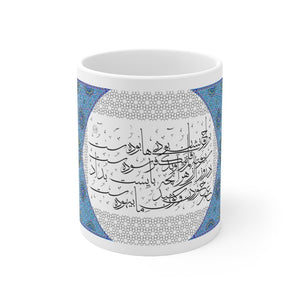
Bliss or Misery, Omar Khayyam Poetry
by Amro ZoabeBliss or Misery is a stanza from the famous Rubayyat of famous Islamic Persian poet, philosopher, mathematician, and scientist, Omar Khayyam.
Omar Khayyam عمر خیّام; was born on the 18th of May 1048 and passed away on the 4th of December 1131. Omar Khayyam was born in an area north-eastern of the historical land of Persia, in a city called Nishapur, now modern day Razavi Khorasan Province in Iran. Omar Khayyam was a multi-talented man. He was a poet, a mathematician, a philosopher, and an astronomer. He shined the most during the Seljuks state, close to the time of the First Crusade.
In astronomy, his works where highlighted through his development of the Jalali calendar. The Jalali calendar is a solar calendar using an incredibly focused 33-year intercalation cycle. His calendar was used as the basis for the Persian calendar that is still around after almost a millennium. In mathematics, two of his most known works are his contribution to the understanding of the parallel axiom as well as providing geometric solutions of cubic equations. In poetry, Omar Khayyam's quatrains (rubāʿiyāt رباعیات) came as a definition of Persian poetry.
The Persian calligraphy writing "بر لوح’ نشانِ بودنى ها بوده ست. بيوسته قلم ز نيكـ وبد فرسوده ست در روزِ ازل هر آنجه بايِست، بداد. غم خوردن و كوشيدنِ ما بيهود ست" has a literal translation of "Twas writ at first, whatever was to be, By pen, unheeding bliss or misery, Yea, writ upon the tablet once for all, To grieve or strive is all but vanity." In a more simplified English, it means: "On the eternal day, we as human beings have been given all the things we need to live on the earth. Thus, we should not envy things we don’t have since those things are ingrained in our existence. We only need to find them."
This design was suggested by Helen Righton, an appreciator of Persian literature.
Arabic and Persian writing are usually viewed with suspicion and fear as many people associate them unjustifiably with terrorism. Thus, through showing the beauty of Arabic and Persian writing and Arabic and Persian calligraphy via printing them on hippie T-shirts, sweatshirts, hoodies, tank tops, mugs, canvas, tote cotton bags, and mouse pads; we hope to change the perception of Arabic and Persian writing towards admiration and appreciation.
-
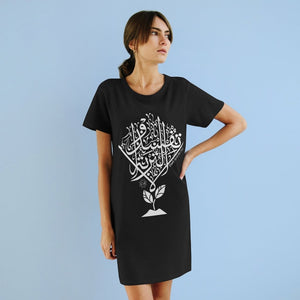
Don't Spoil the Soil
by Amro ZoabeDon't Spoil the Soil! is inspired by the saddening degradation of the soil cover worldwide.
Soil all around the world, is having its quality compromised through loss of valuable chemicals and organic materials, change is physical structure, drought, and erosion. This leads to the soil being less fertile, as the upper layer of soil is disappearing. Needless to say, the ecosystem suffers greatly, and thus humans suffer as a consequence, but also as a causing factor.
The Arabic calligraphy writing "لا تفسدوا التربة" was the literal translation of the phrase "Don't Spoil the Soil!". This call to "inaction" for people to stop the harmful practices that damage the soil including unregulated farming, mining, and unplanned developments. The use of small, growing plant, symbolises the life force captured and provide to Earth by the soil.
Arabic writing is usually viewed with suspicion and fear as many people associate it unjustifiably with terrorism. Thus, through showing the beauty of Arabic writing and Arabic calligraphy via printing it on hippie T-shirts, sweatshirts, hoodies, tank tops, mugs, canvas, tote cotton bags, and mouse pads; we hope to change the perception of Arabic writing towards admiration and appreciation.
-
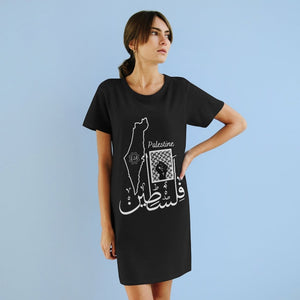
Palestine Design
by Amro ZoabeThe Palestine design was inspired by the never-ending perseverance of the Palestinian identity in the many faces of injustices throughout history.
Palestine is a beautiful nation with a lot of history and ever-lasting cultural influence on the Levant region. Palestine has many landmarks including Al-Aqsa Mosque, Abraham (Al-Ibrahimi) Mosque, Old City, Western Wall, Dome of the Rock, Church of the Nativity, Great Mosque of Gaza, Mosque of Prophet Yunus, Great Mosque of Nablus, Mar Saba Monastery, Tomb of the Prophet Haggai, Zechariah and Malachi, Hisham's Palace, Underground Passages and Necropolis Under City of David, Tell Umm El'Amr, Herodium (Herod's Palace), Dome of the Chain, Milk Grotto, Mount of Temptation Monastery, The Church of St. Catherine, Sanctuary Bethlehem, Dar Zahran Heritage Building, Cave of St. Jerome, Hisham's Palace, Aida Camp, Tomb of Rachel (Kever Rachel), Star Street, Carmel of the Holy Child Jesus, Cave of the Patriarchs, The Monastery of Saint Gerassimos, Gush Etzion Heritage Centre, Jacob's Well, Zaccheus' Tree, Tel es-Sultan, Nabi Musa, The Good Samaritan Museum, Ein Prat Nature Reserve (Wadi Qelt), Mosque of Omar, Masjid-el-Khalil Mosque, Shepherd's Sanctuary, Genesis Land, Ancient Shiloh (Tel Shiloh), Cremisan Monastery, Mansour House, Campo dei Pastori, Shalom Al Yisrael Synagogue, Susya - National Heritage Site, Great Mosque of Gaza, Mosque of Prophet Yunus, Great Mosque of Nablus, Al Khader Church, Churuch of St. Lazarus, Yasser Arafat Square, Balm of Gilead Farm - Biblical Agricultural Revived, Tower of David, Western Wall Tunnel, City of David, Timna Park, Walls of Jerusalem, Caesarea National Park, Qumran National Park, Ben-Gurion House, Al-Jazzar Mosque, Carda, Bethesda, Nimrod Fortress National Park, Christ Church Jerusalem, Palmach Museum, Monument of the Negev Brigade, Solomon's Pools, Bible Lands Museum, Antonia Fortress, Khirbet Kerak, Museum of Underground Prisoners, Tell Balata, The Biyar Aqueduct, St. Mary Church for Greek Orthodox, Annunciation Latin Parish, Saint Nicholas Church, Mount Eival, Beitillu Nature Reserve, Aor Hbib Synagogue, Nablus Old City, Syriac Orthodox Monastery of Saint Mark, Church of the Holy Sepulchre, Mary's Tomb, Church of Saint Porphyrius, and Chapel of Saint Helena.
Influential cities of Palestine include: Al-Quds (Jerusalem), Bethlehem, Gaza, Ramallah, Al-Khalil (Hebron), Nablus, Tulkarm, Jenin, Al-Naseryyah (Nazareth), Tiberias, Akka (Acre), Haifa, Al-Khadayrah (Hadera), Netanya, Yafa, Ashdod, Rafah, Khan Yunis, BeerSheba (Be'er Sheva), Qalqilya, Bet Shemesh, Ramla, and Lod.
The Arabic calligraphy writing "فلسطين" is the Arabic Translation of "Palestine". The map used is the complete map of Palestine including the Golan Heights. The stamp is designed by Levant 2 Australia owner and symbolises the Palestinian diaspora. The background of the stamp is a Palestinian Koufiyah (type of scarf) that in itself has a lot of symbolism. The intersecting central lines represent the fishnets Palestinian people use to fish. The wavy surrounding lines, represent the agricultural practices of the people. The fist represent the struggle for justice that Palestinians have been undergoing for centauries.
Arabic writing is usually viewed with suspicion and fear as many people associate it unjustifiably with terrorism. Thus, through showing the beauty of Arabic writing and Arabic calligraphy via printing it on hippie T-shirts, sweatshirts, hoodies, tank tops, mugs, canvas, tote cotton bags, and mouse pads; we hope to change the perception of Arabic writing towards admiration and appreciation.
-
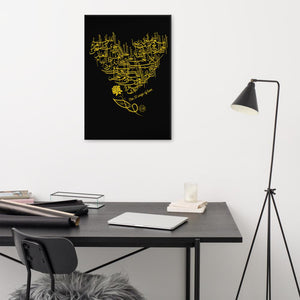
The 31 Ways of Love
by Amro ZoabeThe 31 Ways of Love is inspired by the endless ways of communicating love in the Arabic language.
The 31 words "ways" of love are what the author managed to find after days of research. There are definitely a lot more words.
The words in the design are:
الشهوة [Ash-Shahwa] which is the raw sexual love. Can be translated as "lust".
الغمرة [Al-Ghamra] which is the flowing movement of a stream like the flowing love emotions through the lover's vein.
الإعجاب [Al-Iejab] which is a low degree of love, more like liking someone or having a "crush" on them.
الحلم [Al-Hilm] which means the type of love that involves a high degree of caring and sympathy. Not necessarily in a romantic way.
التباريح السدم [Al-Tabareeh As-Sudom] which is a very intense degree of love, only in a romantic way.
الصبابة [As-Ssbaba] which is light love, based on sending sweet enjoyable time together, no intensity or drama.
الوله [Al-Walah] which is the immense sadness that leads to the loss of the lover's mind due to the strong emotions attached to this love.
الحب [Al-Hub] which means the standard love.
الاستكانة [Al-Istikana] which means the absolute submission to the lover in all aspects of life.
الحنين [Al-Haneen] which means nostalgia one feels to one's lover regardless whether the distance is literal or metaphorical.
الوصب [Al-Wassab] which is the ever-lasting love that never goes away.
الوجد [Al-Wujad] which is a very intense form of love.
الهوى [Al-Hawa] which means the light and tender feeling of love and joy that one feels for lovers, friends, and even objects and experiences.
الصبوة [As-Ssbwah] which is the youthful love.
الشغف [Ash-Shaghaf] which means love that is mixed with passion.
العشق [Al-Ishiq] which means admiration and adoration of a person. This is specialised for romantic love only.
النجوى [Ann-Najwa] which is the secretive love that is held with reverence and the lover choses to keep it a secret, to enjoy it for themselves.
الخبل [Al-Khabal] which is the love that corrupts the mind and leads to madness.
الكلف [Al-Kilf] which is the love that goes over the rational limit.
الشوق [Ash-Shawq] which is missing someone due to the love you have for them.
الود [Al-Wid] which is the friendly love that can be between any two people.
الخلابة [Al-Khalabah] which is the love where the lover fails to see any negative characteristics in their loved one. They become completely blinded by their love.
الولع [Al-Walaa] which is the love that creates an unbroken attachment between lovers.
العشرة [Al-Ishrah] which is the love that grows after spending a lot of time together and becoming familiar with one another.
الجوى [Al-Jawa] which is a high degree of love that causes grief.
الشجن [Ash-Shajan] which is a form of love that stimulates all the other feelings a human can feel with it.
الغرام [Al-Gharam] which is the love that causes dependency from the lover on the loved one.
الفتون [Al-Futoon] which is the love resulted from seduction and persuasion.
التتيم [At-Ttatayyum] which is the love that enslaves the heart for the loved one.
التعبد [Al-Taabud] which is one of the highest level of love, as the lover starts worshipping their loved one.
الهيام [Al-Huyam] which is the highest level of love. At this stage, the lover would have gone completely insane as their mind can no longer tolerate the love they have for their loved one.
Arabic writing is usually viewed with suspicion and fear as many people associate it unjustifiably with terrorism. Thus, through showing the beauty of Arabic writing and Arabic calligraphy via printing it on hippie T-shirts, sweatshirts, hoodies, tank tops, mugs, canvas, tote cotton bags, and mouse pads; we hope to change the perception of Arabic writing towards admiration and appreciation.
-
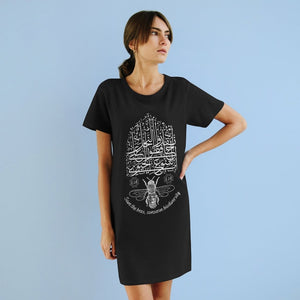
Save the Bees! Conserve Biodiversity!
by Amro ZoabeSave the Bees! Conserve Biodiversity! is inspired by the importance and contribution of bees into the Earth's biodiversity.
Bees contribute in so many ways to the health of the environment and the ecosystems. Bees are pollinators, and thus they help the growth of flowers, trees and many other plants. This green cover is needed to capture Carbon in the atmosphere. Bees role as a connector between complex ecosystems, positions them as an invaluable asset to the environment. Many bee populations are at risk of extensions due to the destruction of their natural habitat. Through saving their natural habitat, we maintain a healthy bee population and thus a healthier environment.
The Arabic calligraphy writing "انقذوا النحل، حافظوا على التنوع الحيوي" was the literal translation of the phrase "Save the Bees! Conserve Biodiversity!". This encouragement to take better care of the environment that provide bees with a home. The bee in the design, represent the different type of bees in the world.
Arabic writing is usually viewed with suspicion and fear as many people associate it unjustifiably with terrorism. Thus, through showing the beauty of Arabic writing and Arabic calligraphy via printing it on hippie T-shirts, sweatshirts, hoodies, tank tops, mugs, canvas, tote cotton bags, and mouse pads; we hope to change the perception of Arabic writing towards admiration and appreciation.
-
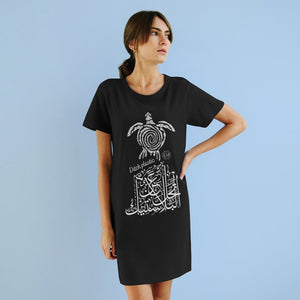
Ditch Plastic! - Turtle Design
by Amro ZoabeThe Ditch Plastic! - Turtle Design is inspired by the suffering that animals undergo from humans' plastic waste.
Every year, humans produce millions of tons in plastic that inevitably end up in the oceans, creating a garbage island bigger than France. This plastic takes centauries to biodegrade if at all, meaning that animals over generations would struggle with it. Many animals get stuck in plastic bags, straws, and caps. The pictures showing the extend of pain and deformity that these animals go through are extremely heart-breaking. Microplastics as well enter the food chain of both animals and humans leading to many health problems.
The Arabic calligraphy writing "تخل عن البلاستيك" was the literal translation of the phrase "Ditch plastic". This encouragement to reduce or even fully stop the use of plastic products, aims to reduce the human waste and protect the environment. The turtle in the design, represent the animals that suffer from our plastic waste, as many pictures and videos of turtles stuck in plastic were circulated around the internet, becoming a symbol for marine life suffering.
Arabic writing is usually viewed with suspicion and fear as many people associate it unjustifiably with terrorism. Thus, through showing the beauty of Arabic writing and Arabic calligraphy via printing it on hippie T-shirts, sweatshirts, hoodies, tank tops, mugs, canvas, tote cotton bags, and mouse pads; we hope to change the perception of Arabic writing towards admiration and appreciation.
-
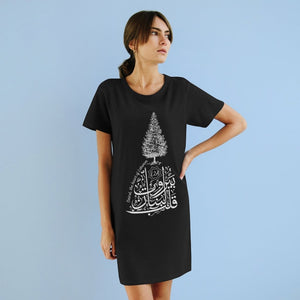
Beirut, the heart of Lebanon - Cedar Design
by Amro ZoabeBeirut, the heart of Lebanon - Cedar Design is inspired by the beautiful city of Beirut and Lebanon in general.
Beirut is a beautiful city with a lot of history and diverse population. It is the capitol of Lebanon, the country of heritage for many Australians. Beirut has many landmarks including: National Museum of Beirut, Sursock Museum, Hamra, Mohammad AlAmin Mosque, Gouraud, Zaituna Bay, Martyrs' Square, Corniche Beirut, Raouche Rocks, Verdun St, Saint George Maronite Cathedral, AlOmari Grand Mosque, Sanayeh, Beit Beirut - Museum and Urban Cultural Center, MIM Mineral Museum, Saint George Greek Orthodox Cathedral, Badaro, Place de l'Étoile, Sursock Palace, American University of Beirut Museum, Roman Bath Vestiges, Villa Audi Mosaic Museum, Beirut Luna Park, Downtown Beirut, Ramlet Al Baida Beirut Lebanon, Dalloul Art Foundation, Dar El-Nimer for Arts and Culture, Galerie Janine Rubeiz, AUB Beach, Maghen Abraham Synagogue, La Maison Rose, Musée de la Préhistoire Libanaise, Prince Monzer - Mosque, Saint Elias and Saint Gregory the Illuminator Armenian Catholic Cathedral, Marfa' contemporary art gallery, Mzaar Ski Resort kfardebiane Jonction slop, Corniche El Manara, St Elias Greek Catholic Cathedral, Mansour Assaf - Mosque, St. Maroun Maronite Catholic Church, Saint Louis Cathedral of the Capuchin Fathers, Saint George Greek Orthodox Cathedral Crypt Museum, Heneine palace, St George Rmeil - Greek Orthodox Church, Roman Cardo Maximus, Roman Baths, The Archaeological Museum, Saint Nichan Armenian Orthodox Cathedral, Al-Abed Clock Tower, Ziade Palace, Rene Mouawad Park, Bustros Palace, Sassine Square, St. Elie - Church, Salah El Dine - Mosque, Rashed Al Houri - Mosque, St. Nshan - Church, Omar Bin Abd El-aziz - Mosque, Al Sultan Mohammad Al Fateh - Mosque, Casino du Liban, Lebanon Mountain Trail Association, Holy See of Cilicia, Aïshti Foundation, St Savior Church, Jelly Beans Park, Mar Antonios al Kabir, The Silk Museum - Bsous, Mar Abda - Church, Deir el kalaa, and Cilicia Museum.
The Arabic calligraphy writing "بيروت، قلب لبنان" was the literal translation of of the phrase "Beirut, the heart of Lebanon". Lebanon is a very diverse country with a rich history. Beirut summarises the diversity and history in one place. The Lebanese cedar tree was used as a unique symbol of Lebanon that transcends politics and religion.
Arabic writing is usually viewed with suspicion and fear as many people associate it unjustifiably with terrorism. Thus, through showing the beauty of Arabic writing and Arabic calligraphy via printing it on hippie T-shirts, sweatshirts, hoodies, tank tops, mugs, canvas, tote cotton bags, and mouse pads; we hope to change the perception of Arabic writing towards admiration and appreciation.
-

Ocean Spirit, Whale Design
by Amro ZoabeThe Ocean Spirit, Whale Design is inspired by the ongoing dangers facing our oceans and the human impact on the health of the ocean overall and the ecosystem within them.
Humans' agricultural and industrial activities result waste that goes through water streams to the oceans. This waste comes in many forms including plastic, chemical, and metals. Fish and other living organisms suffer greatly and gradually drift towards extension. Not just waste that harms the oceans; extensive fishing and whaling contributes to the struggles in the oceans. I strongly believe that humans have the moral responsibility to protect and rehabilitate the ocean.
The Arabic calligraphy writing "لنحمي محيطاتنا" was the literal translation of "Let's protect our oceans". The whale and flower symbolises the beauty of the ocean and its creatures.
Arabic writing is usually viewed with suspicion and fear as many people associate it unjustifiably with terrorism. Thus, through showing the beauty of Arabic writing and Arabic calligraphy via printing it on hippie T-shirts, sweatshirts, hoodies, tank tops, mugs, canvas, tote cotton bags, and mouse pads; we hope to change the perception of Arabic writing towards admiration and appreciation.
-
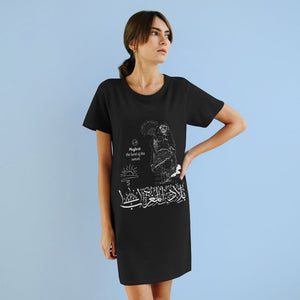
The Land of the Sunset, Maghreb Design
by Amro ZoabeThe Land of the Sunset, Maghreb Design is inspired by the rich history and the diversity of the Maghreb region in northwest Africa.
The Maghreb region compromises of seven nations, People's Democratic Republic of Algeria, State of Libya, Islamic Republic of Mauritania, Kingdom of Morocco, Republic of Tunisia, and Western Sahara. The Maghreb region is filled with culturally-rich landmarks including: Koutoubia Mosque, Tassili n'Ajjer National Park, The Great Mosque of Tlemcen, Beni Hammad Fort, The Great Mosque of Kairouan, Borj Nord, Dar Hussein, Al-Zaytuna Mosque, The Todgha Gorges, Kasbah Museum, Royal Mausoleum of Tourbet el Bey, Basilique Notre Dame d'Afrique, Monument of the Martyr, Ouzoud Falls, Kasbah des Caids, The Temple Beth-El (Jewish synagogue in Casablanca), The Ribat of Monastir, El Ghriba synagogue, Le Jardin Secret, The Museum of Marrakech, The Agdal Gardens, Bab Agnaou, Dar Ben Abdallah, The Madrasa of Abu al-Hasan, The Menara Gardens, The Mausoleum of Mohammed V, Almoravid Koubba, Dar Jamai Museum, Kasbah Square, Dar Lasram, Lahdim Square, Cathedral of St Vincent de Paul, Aben Danan Synagogue, Hassan Tower, Castelo Real of Mogador, Dar Batha, Saadien's Tombs, Bou Inania Madrasa, Nejjarine Fondouk, Jemaa el-Fna, Bardo National Museum, Chellah, El Badii Palace, Bahia Palace, Al Attarine Madrasa, Kasbah of the Udayas, The son of Joseph School, Hassan II Mosque, Jardin Majorelle, and The Atlas Mountains.
The Arabic calligraphy writing "بلاد المغرب" means literally "Maghreb" which is an Arabic terms that refers to where the sun sets, or land of the sunset. As historically, the Maghreb region was as far west as the Arabic-speaking civilisations could travel, and hence the name originated. The sunset drawing is used to communicate the meaning further. The man in the picture is wearing a traditional Maghreb outfit that suits the diverse landscapes of the region.
Arabic writing is usually viewed with suspicion and fear as many people associate it unjustifiably with terrorism. Thus, through showing the beauty of Arabic writing and Arabic calligraphy via printing it on hippie T-shirts, sweatshirts, hoodies, tank tops, mugs, canvas, tote cotton bags, and mouse pads; we hope to change the perception of Arabic writing towards admiration and appreciation.
-
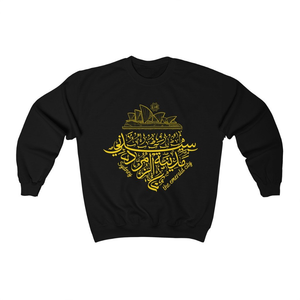
The Emerald City, Sydney Design
by Amro ZoabeThe Emerald City, Sydney Design is inspired by the biggest city and cultural centre of Australia, the city of Sydney.
Sydney is a beautiful city with a lot of history and diverse population, that represents the spirit of Australia as a proud multicultural country that is build on fair go and egalitarianism. Sydney has many landmarks including The Sydney Opera House, The Rocks, The Rocks Discovery Museum, Sydney Tower Eye, Queen Victoria Building, Sydney Harbour Bridge, Sydney Observatory, Powerhouse Museum, Bondi Beach, Milk Beach, Manly Beach, Manly Dam, The Blue Mountains, The National Maritime Museum, Spit Bridge, Hyde Park Barracks, Art Gallery of New South Wales, St. Mary’s Cathedral, Kings Cross, Museum of Contemporary Art Australia, Bobbin Head, SEA LIFE Sydney Aquarium, Government House Sydney, Darling Harbour, The Royal Botanic Garden Sydney, ANZAC War Memorial, Barangaroo Reserve, Sydney Town Hall, Sydney Jewish Museum, Great Synagogue, Luna Park, Macquarie Street, St. James Church, Hillsong Church Hills Campus, Parramatta, George Street, Sydney Cenotaph, Mrs. Macquarie’s Chair, Central Railway Station, Taronga Zoo, Anzac Bridge, and Fort Denison.
The Arabic calligraphy writing "سيدني, مدينة الزمرد" was the translation of Sydney's nickname, "The Emerald City". This nickname comes in relation to the famous play "Emerald City" and the Oz books. To find out more about the history of the nickname, visit the website: https://theculturetrip.com/pacific/australia/articles/why-sydney-is-also-known-as-the-emerald-city/
Arabic writing is usually viewed with suspicion and fear as many people associate it unjustifiably with terrorism. Thus, through showing the beauty of Arabic writing and Arabic calligraphy via printing it on hippie T-shirts, sweatshirts, hoodies, tank tops, mugs, canvas, tote cotton bags, and mouse pads; we hope to change the perception of Arabic writing towards admiration and appreciation.
-
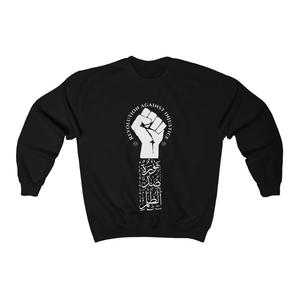
The Justice Seeker, Revolution Design
by Amro ZoabeThe Justice Seeker, Revolution Design is inspired by the spirit of change and desire for justice that is the zeitgeist around the world.
The word "Revolution" is sometimes associated with negative connotations due to the violence and instability that may accompany revolutions. Yet, it is important to remember that most if not all of the rights that we enjoy nowadays and that we consider to be the default were fought for either through peaceful protest or otherwise. Injustice takes many takes many forms, it can be misogyny and sexism, it can be racism and discrimination, it can be colonialism and greed, it can be silencing the free speech. The owner of Levant 2 Australia, had livid in Syria during the first two years of the Syrian Revolution. Regardless of how powerful the "bad guys" are, justice must be served eventually.
The Arabic calligraphy writing "ثورة ضد الظلم" was translated literally into "Revolution against injustice". The injustice is deliberately left ambiguous in the design, as the owner of each individual item would apply their understanding to what the injustice is.
Arabic writing is usually viewed with suspicion and fear as many people associate it unjustifiably with terrorism. Thus, through showing the beauty of Arabic writing and Arabic calligraphy via printing it on hippie T-shirts, sweatshirts, hoodies, tank tops, mugs, canvas, tote cotton bags, and mouse pads; we hope to change the perception of Arabic writing towards admiration and appreciation.
- Page 1 of 3
- Next page












